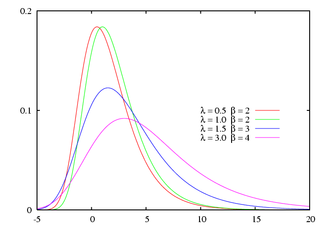| Revision as of 09:01, 25 March 2006 edit128.178.83.22 (talk)No edit summary← Previous edit | Revision as of 09:01, 25 March 2006 edit undo128.178.83.22 (talk)No edit summaryNext edit → | ||
| Line 2: | Line 2: | ||
| name =Fisher-Tippett| | name =Fisher-Tippett| | ||
| type =density| | type =density| | ||
| pdf_image =] | pdf_image =]| | ||
| cdf_image =]| | cdf_image =]| | ||
| parameters =<math>\mu\!</math> ] (])<br /><math>\beta>0\!</math> ] (real)| | parameters =<math>\mu\!</math> ] (])<br /><math>\beta>0\!</math> ] (real)| | ||
Revision as of 09:01, 25 March 2006
Probability density function | |||
Cumulative distribution function | |||
| Parameters |
location (real) scale (real) | ||
|---|---|---|---|
| Support | |||
|
where | |||
| CDF | |||
| Mean | |||
| Median | |||
| Mode | |||
| Variance | |||
| Skewness | |||
| Excess kurtosis | |||
| Entropy |
for | ||
| MGF | |||
| CF | |||
In probability theory and statistics the Gumbel distribution (named after Emil Julius Gumbel (1891–1966)) is used to find the minimum (or the maximum) of a number of samples of various distributions. For example we would use it to find the maximum level of a river in a particular year if we had the list of maximum values for the past ten years. It is therefore useful in predicting the chance that an extreme earthquake, flood or other natural disaster will occur.
The distribution of the samples could be of the normal or exponential type. The Gumbel distribution, and similar distributions, are used in extreme value theory.
In particular, the Gumbel distribution is a special case of the Fisher-Tippett distribution (named after Sir Ronald Aylmer Fisher (1890–1962) and Leonard Henry Caleb Tippett (1902–1985)), also known as the log-Weibull distribution.
Properties
The cumulative distribution function is
The Gumbel distribution is the case where μ = 0 and β = 1.
The median is
The mean is where = Euler-Mascheroni constant = 0.57721...
The standard deviation is
The mode is μ.
Parameter estimation
A more practical way of using the distribution could be
where M is the median. To fit values one could get the median straight away and then vary μ until it fits the list of values.
Generating Fisher-Tippett variates
Given a random variate U drawn from the uniform distribution in the interval (0, 1], the variate
has a Fisher-Tippett distribution with parameters μ and β. This follows from the form of the cumulative distribution function given above.

















 where
where  =
= 


